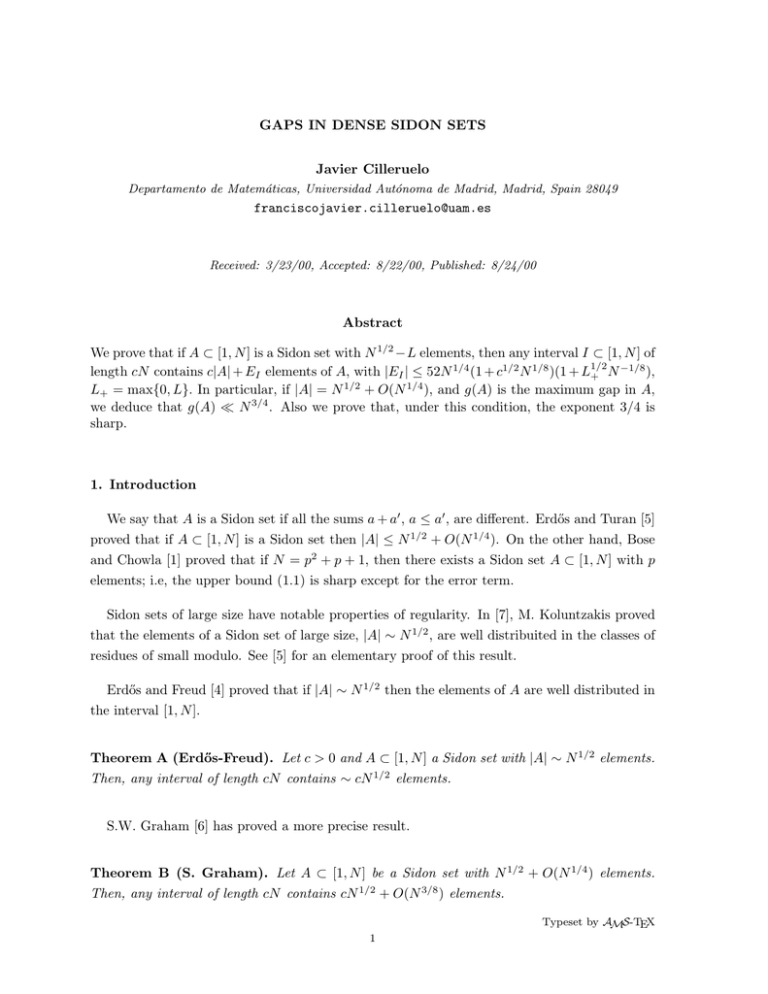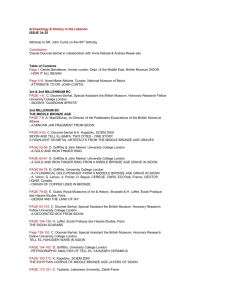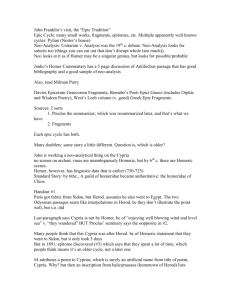GAPS IN DENSE SIDON SETS Javier Cilleruelo
advertisement

GAPS IN DENSE SIDON SETS
Javier Cilleruelo
Departamento de Matemáticas, Universidad Autónoma de Madrid, Madrid, Spain 28049
franciscojavier.cilleruelo@uam.es
Received: 3/23/00, Accepted: 8/22/00, Published: 8/24/00
Abstract
We prove that if A ⊂ [1, N ] is a Sidon set with N 1/2 −L elements, then any interval I ⊂ [1, N ] of
1/2
length cN contains c|A| + EI elements of A, with |EI | ≤ 52N 1/4 (1 + c1/2 N 1/8 )(1 + L+ N −1/8 ),
L+ = max{0, L}. In particular, if |A| = N 1/2 + O(N 1/4 ), and g(A) is the maximum gap in A,
we deduce that g(A) ¿ N 3/4 . Also we prove that, under this condition, the exponent 3/4 is
sharp.
1. Introduction
We say that A is a Sidon set if all the sums a + a0 , a ≤ a0 , are different. Erdős and Turan [5]
proved that if A ⊂ [1, N ] is a Sidon set then |A| ≤ N 1/2 + O(N 1/4 ). On the other hand, Bose
and Chowla [1] proved that if N = p2 + p + 1, then there exists a Sidon set A ⊂ [1, N ] with p
elements; i.e, the upper bound (1.1) is sharp except for the error term.
Sidon sets of large size have notable properties of regularity. In [7], M. Koluntzakis proved
that the elements of a Sidon set of large size, |A| ∼ N 1/2 , are well distribuited in the classes of
residues of small modulo. See [5] for an elementary proof of this result.
Erdős and Freud [4] proved that if |A| ∼ N 1/2 then the elements of A are well distributed in
the interval [1, N ].
Theorem A (Erdős-Freud). Let c > 0 and A ⊂ [1, N ] a Sidon set with |A| ∼ N 1/2 elements.
Then, any interval of length cN contains ∼ cN 1/2 elements.
S.W. Graham [6] has proved a more precise result.
Theorem B (S. Graham). Let A ⊂ [1, N ] be a Sidon set with N 1/2 + O(N 1/4 ) elements.
Then, any interval of length cN contains cN 1/2 + O(N 3/8 ) elements.
Typeset by AMS-TEX
1
2 INTEGERS: ELECTRONIC JOURNAL OF COMBINATORIAL NUMBER THEORY 0 (2000), #A11
If we denote by g(A) = maxak−1 ,ak ∈A {ak − ak−1 } the maximum gap in A, from the Theorem
B it is easy to deduce that if A is a Sidon set A ⊂ [1, N ] with N 1/2 +O(N 1/4 ), then g(A) ¿ N 7/8 .
In this paper we shall use an identity (Lemma 2.1), which was introduced in [2] and [3], to
obtain a better result.
Theorem 1.1. Let A ⊂ [1, N ] a Sidon set with N 1/2 − L elements. Then, any interval of
length cN contains c|A| + EI elements of A, with
|EI | ≤ 52N 1/4 (1 + c1/2 N 1/8 )(1 + L+ N −1/8 ),
1/2
L+ = max{0, L}.
In particular we deduce from this theorem the following corollary for gaps.
Corollary 1.1. If A ⊂ [1, N ] is a Sidon set and |A| = N 1/2 + O(N 1/4 ), then g(A) ¿ N 3/4 .
It is easy to see that the exponent 3/4 is the best possible if A ⊂ [1, N ] is a Sidon set with
√
|A| = N 1/2 +O(N 1/4 ). Consider N = p2 +p+1, and a Sidon set A, A ⊂ [1, N ] with p ≥ N −1
elements. If we split the interval [1, N ] in intervals of length [N 3/4 ], then, one of them contains
less than 2N 1/4 elements. If we remove these elements from A we have a Sidon set A0 with
|A0 | = N 1/2 + O(N 1/4 ) elements and g(A0 ) À N 3/4 .
We don’t know how to derive a better estimate for g(A) when the error term is less than
N . It is related with the difficulty of improving the error term in the upper bound for finite
Sidon sets. It would be interesting to know a good upper bound for g(A) when A is a Sidon
set of maximal size. Maybe, it is possible an upper bound like g(A) ¿ N 1/2+² .
1/4
It should be noted that the classical construction of Erdős and Turan [5] of Sidon sets,
Ap = {2kp + (k 2 )p : k = 0, 1, . . . , p − 1}, gives g(A) ¿ N 1/2 for these sets. It seems not
to be the case for the Ruzsa’s construction [8] of finite Sidon sets. Numerical and heuristic
arguments suggest that g(A)/N 1/2 → ∞ in this case. In particular, it would imply that the
Erdős’s Conjecture, F (N ) ≤ N 1/2 + O(1), is not true.
2. Proofs
The proof of the following lemma can be found in [2] or [3].
Lemma 2.1. Let A ⊂ [1, N ] be a sequence of integers. Then, for any integer H ≥ 1 we have
2
X
1≤h≤H
d(h)(H − h) =
H 2 |A|2
− H|A| + DH ,
N +H −1
INTEGERS: ELECTRONIC JOURNAL OF COMBINATORIAL NUMBER THEORY 0 (2000), #A11 3
where
µ
X
DH =
H|A|
A(n) − A(n − H) −
N +H −1
1≤n≤N +H−1
A(n) is the counting function of A and d(h) = #{h = a − a0 ;
¶2
,
a, a0 ∈ A}.
¤
A(n) − A(n − H) is the number of elements of A lying in the interval (n − H, n] and the
quantity NH|A|
+H−1 is the expected value of A(n) − A(n − H). Then, DH is a measure of the
distribution of the elements of A in the interval [1, N + H − 1].
The argument of the proof of the Theorem 1.1 is the following: If |A| is close to N 1/2 , (L
small), then DH is “small” and consequently, the number of elements of A lying in intervals
of length H is “close”, at least in average, to the expected number. From that we can deduce
a “good” distribution in any interval I = (αN, βN ]. Upper and lower bounds for the error
EI = |A ∩ I| − (β − α)|A| are obtained in two different steps (Lemma 2.3 and Lemma 2.4).
Lemma 2.2. If A ⊂ [1, N ] is a Sidon set with |A| = N 1/2 − L then, for any integer H we have
DH ≤
3H 2 L+
H3
+ 2HN 1/2
+
N
N 1/2
where L+ = max{0, L}.
Proof. We apply Lemma 2.1 to the sequence A. Since A is a Sidon set, hence d(h) ≤ 1 for any
P
integer h ≥ 1 and 2 1≤h≤H−1 d(h)(H − h) ≤ H 2 . Also we use the trivial estimate for the size
of a Sidon set, |A| ≤ 2N 1/2 .
DH ≤ H 2 −
H 2 N + H 3 − H 2 − H 2 |A|2
H 2 |A|2
+ H|A| =
+ H|A|
N +H −1
N +H −1
≤
If L ≤ 0 , then DH ≤
If L > 0, then DH ≤
H3
N
H 2 (N −|A|2 )
N
+
H3
N
+ 2HN 1/2 .
+ 2HN 1/2 .
H2
1/2
N (N
+ |A|)L+ +
H3
N
+ 2HN 1/2 ≤
3H 2 L+
N 1/2
+
H3
N
+ 2HN 1/2 .
¤
Let I = (αN, βN ], c = β − α and we write |A ∩ I| = c|A| + EI . We will choose H = [N 3/4 ]
in all the proofs.
4 INTEGERS: ELECTRONIC JOURNAL OF COMBINATORIAL NUMBER THEORY 0 (2000), #A11
Lemma 2.3. EI ≤ 10N 1/4 (c1/2 N 1/8 + 1)(L+ N −1/8 + 1).
1/2
Proof. We write IH = (αN, βN + H], then cN + H − 1 ≤ |IH | ≤ cN + H + 1. We have
X
A(n) − A(n − H) ≥ H|A ∩ I|,
n∈IH
since each a ∈ A ∩ I is counted H times in the sum. Then,
¶
X µ
|IH |H|A|
H|A|
≥ H|A ∩ I| −
A(n) − A(n − H) −
N +H −1
N +H −1
n∈IH
µ
= EI H + H|A| c −
|IH |
N +H −1
Then
EI ≤ H
−1
¶
≥ EI H − H|A|
(1 − c)(H + 1)
H 2 |A|
≥ EI H −
.
N +H −1
N
X µ
n∈IH
H|A|
A(n) − A(n − H) −
N +H −1
¶
+
H|A|
.
N
Now we apply Cauchy’s inequality, Lemma 2.1 and the trivial estimates |A| ≤ 2N 1/2 ,
N 3/4 /2 ≤ H ≤ N 3/4 to get
EI ≤ H −1 |IH |1/2 DH +
1/2
H|A|
N
Ã√
!
1/2
3/2
√
3HL
H
H|A|
+
≤ H −1 (cN )1/2 + (H + 1)1/2
+ 1/2 + 2H 1/2 N 1/4 +
1/4
N
N
N
³
´ ³√
´
√
√
1/2
3N 1/2 L+ + N 5/8 + 2N 5/8 + 2N 1/4
≤ 2N −3/4 c1/2 N 1/2 + 2N 3/8
´³
´
³
1/2
≤ 10N 1/4 c1/2 N 1/8 + 1 L+ N −1/8 + 1 . ¤
³
´
Lemma 2.4. −EI ≤ 52N 1/4 (c1/2 N 1/8 + 1)(L+ N −1/8 + 1).
1/2
Proof.
X
A(n) − A(n − H) ≤ H (|A ∩ I| + |A ∩ (αN − H, αN ]| + |A ∩ (βN, βN + H]|) .
n∈IH
We apply Lemma 2.3 to the intervals (αN − H, αN ] and (βN, βN + H] to obtain an upper
bound for the last two terms.
¶³
µ 1/2 1/8
´
H N
H
1/2 −1/8
1/4
+
1
L
N
+
1
|A∩(αN −H, αN ]|+|A∩(βN, βN +H]| ≤ 2 |A|+20N
+
N
N 1/2
≤ 4N 1/4 + 40N 1/4 (L+ N −1/8 + 1) ≤ 44N 1/4 + 40N 1/8 L+ .
1/2
1/2
INTEGERS: ELECTRONIC JOURNAL OF COMBINATORIAL NUMBER THEORY 0 (2000), #A11 5
Then,
X µ
A(n) − A(n − H) −
n∈IH
H|A|
N +H −1
µ
¶
≤ H|A ∩ I| −
|IH |
= EI H + H|A| c −
N +H −1
¶
´
³
|IH |H|A|
1/2
+ H 44N 1/4 + 40N 1/8 L+
N +H −1
³
´
1/2
+ H 44N 1/4 + 40N 1/8 L+
1/2
≤ EI H + H(44N 1/4 + 40N 1/8 L+ ),
because |IH | ≥ cN + H − 1.
Finally we apply Cauchy inequality and Lemma 2.2 to obtain
¯
X ¯
1/4
1/8 1/2
−1
¯A(n) − A(n − H) −
−EI ≤ 44N
+ 40N L+ + H
¯
n∈IH
¯
H|A| ¯¯
N + H − 1¯
≤ 44N 1/4 + 40N 1/8 L+ + 2N −3/4 |IH |1/2 DH
!
Ã
³
´ √3HL1/2
3/2
√
1
−3
1
1
H
+
≤ 44N 4 + 40N 8 L+2 + 2N 4 (cN )1/2 + (H + 1)1/2
+ 1/2 + 2H 1/2 N 1/4
N 1/4
N
³
´ ³√
´
√
√
1/2
1/2
3N 1/2 L+ + N 5/8 + 2N 5/8
≤ 44N 1/4 + 40N 1/8 L+ + 2N −3/4 c1/2 N 1/2 + 2N 3/8
1/2
1/2
≤ 52N 1/4 (1 + c1/2 N 1/8 )(1 + L+ N −1/8 ). ¤
1/2
Lemma 2.3 and Lemma 2.4 imply Theorem 1.1. To prove Corollary 1.1, suppose that A =
− L, with L+ ≤ kN 1/4 , and let I be any interval of length k 0 N 3/4 . If we apply Lemma
2.4 we have
N
1/2
|A ∩ I| >
k0
1/2
1/2
|A| − 52N 1/4 (1 + k 0 )(1 + k 1/2 ) > k 0 N 1/4 − kk0 − 52N 1/4 (1 + k 0 )(1 + k 1/2 ).
N 1/4
If we take k 0 large enough, k 0 > 10000k, then |A ∩ I| > 0 for any interval of length greater than
k0 N 3/4 .
References
1. R.C. Bose and S. Chowla, Theorems in the additive theory of numbers, Comment. Math.
Helvet 37 (1962-3), 141-147.
2. J. Cilleruelo, New upper bounds for Bh sequences, (preprint).
3. J. Cilleruelo and G. Tenenbaum, An overlapping lemma and applications, (preprint).
6 INTEGERS: ELECTRONIC JOURNAL OF COMBINATORIAL NUMBER THEORY 0 (2000), #A11
4. P. Erdős and R. Freud, On Sums of a Sidon-Sequence, J. Number Theory 38 (1991), 196-205.
5. P. Erdős and P. Turan, On a problem of Sidon in additive number theory and on some
related problems, J. London Math. Soc. 16 (1941), 212-215;P. Erdős, Addendum 19 (1944),
208.
6. S.W. Graham, Bh sequences, Proceedings of a Conference in Honor of Heini Halberstam
(B.C.Berndt, H.G.Diamond, A.J.Hildebrand, eds.), Birkhauser, 1996, pp. 337-355.
7. M. Kolountzakis, On the uniform distribution in residue classes of dense sets of integers
with distinct sums, J. Number Theory 76 (1999), 147-153.
8. I. Ruzsa, Solving a linear equation in a set of integers I, Acta Arithmetica LXV.3 (1993),
259-282.






